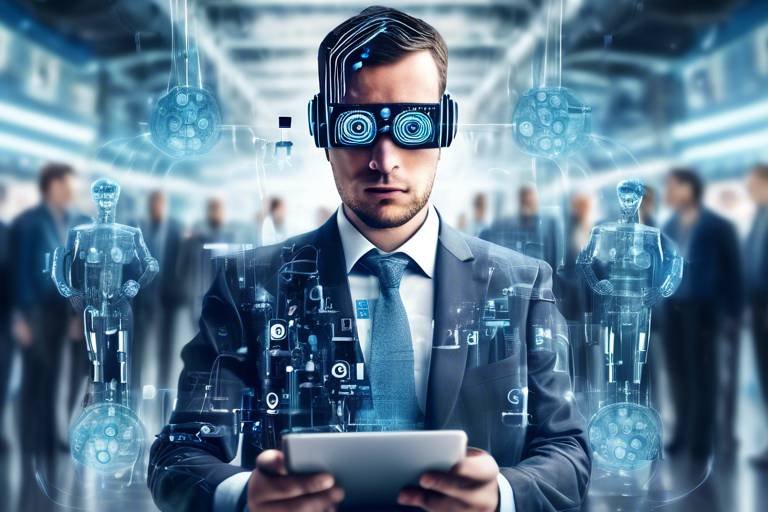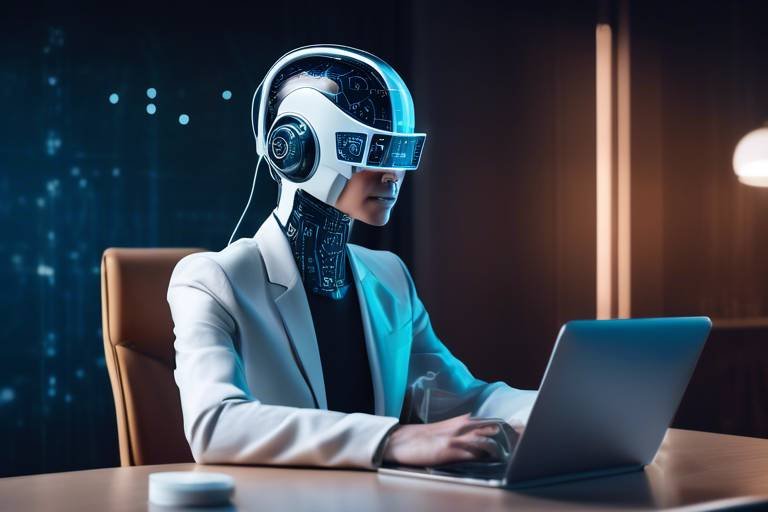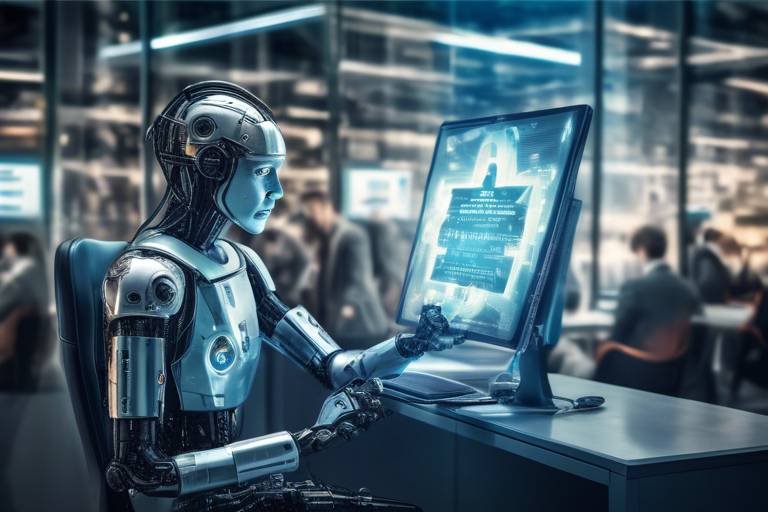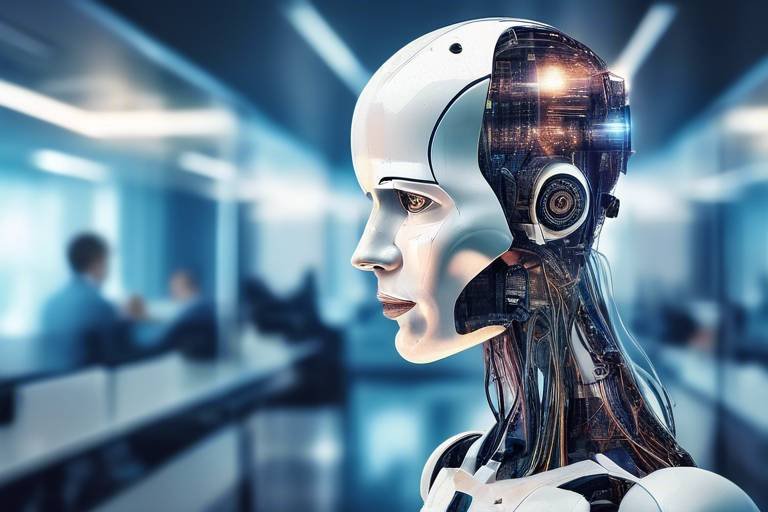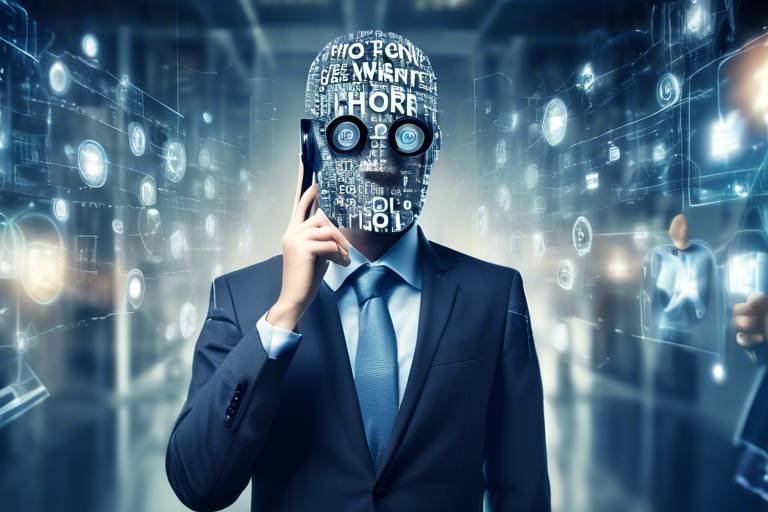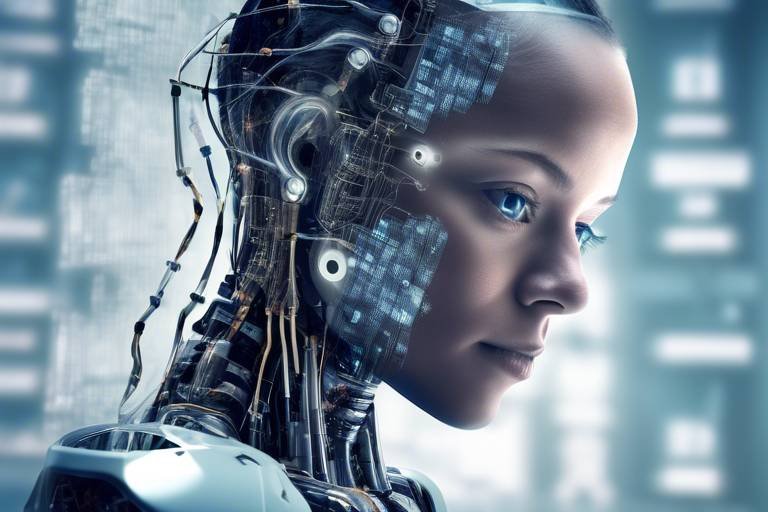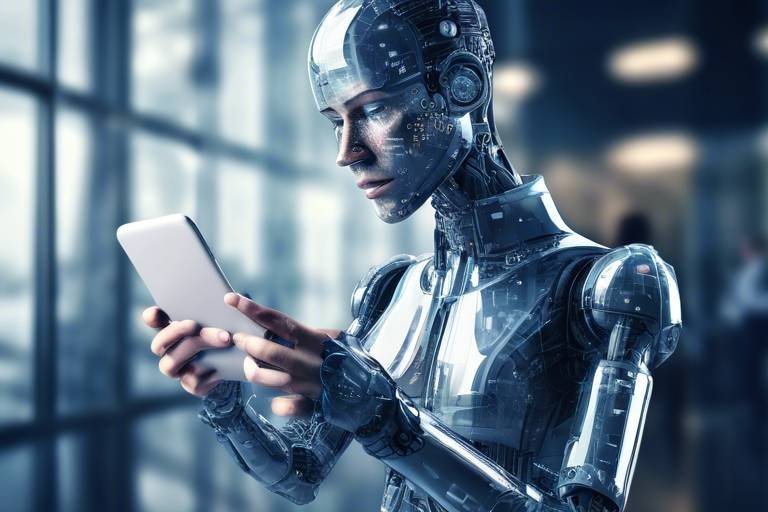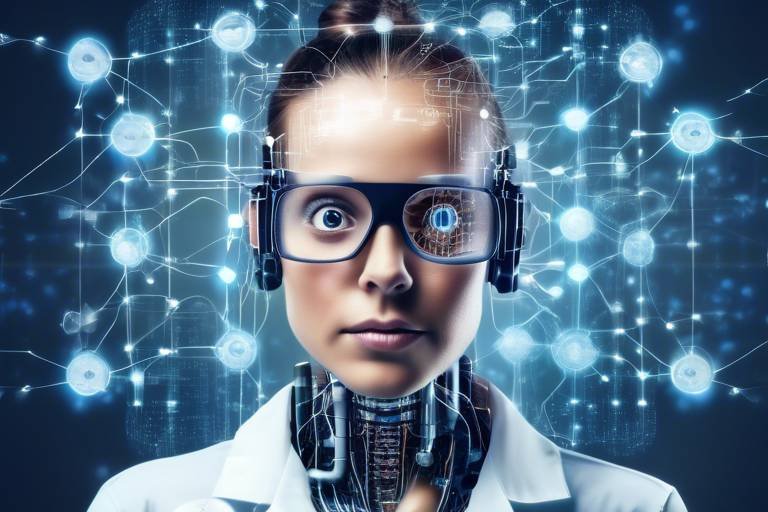AI and Worker Productivity: A Glance at the Future
The workplace is undergoing a seismic shift, and at the heart of this transformation is Artificial Intelligence (AI). As we step into a future where technology and human effort intertwine, the impact of AI on worker productivity becomes a focal point worth exploring. You might be wondering, how exactly is AI changing the way we work? Well, let’s dive into this fascinating landscape where machines are not just tools, but partners in productivity.
AI technology is not just a buzzword; it’s a reality that is increasingly integrated into various industries. From manufacturing to retail, AI is revolutionizing how tasks are performed and enhancing overall efficiency. According to recent statistics, over 70% of organizations are already utilizing AI in some form. This integration is not merely about replacing human effort; it’s about augmenting it. Imagine having a virtual assistant that can handle mundane tasks while you focus on strategic initiatives. That’s the promise of AI in the workplace.
One of the most significant advantages of implementing AI tools in the workplace is the ability to streamline workflows. By automating repetitive tasks, AI frees up valuable time for employees to engage in more creative and strategic endeavors. Picture this: instead of spending hours sorting through data or managing schedules, employees can focus on innovation and problem-solving. Here are some key benefits businesses experience when implementing AI solutions:
- Increased Efficiency: AI can process information faster than any human, leading to quicker decision-making.
- Cost Savings: Automation reduces labor costs and minimizes human error, resulting in substantial savings.
- Enhanced Data Insights: AI tools can analyze vast amounts of data, providing insights that were previously unattainable.
By automating mundane tasks, AI allows employees to focus on what truly matters. Think of AI as that friend who takes care of the boring chores, allowing you to channel your energy into more fulfilling activities. For instance, AI can handle tasks such as:
- Data entry and management
- Scheduling meetings
- Customer support through chatbots
These examples illustrate how AI can effectively handle routine tasks, leaving employees with the mental bandwidth to innovate and create.
Real-world examples abound, showcasing how companies have successfully implemented AI for task automation. Take, for instance, a leading e-commerce giant that integrated AI-driven chatbots into their customer service operations. The result? A 30% increase in customer satisfaction and a dramatic reduction in response times. Similarly, a manufacturing firm employed AI to optimize its supply chain, leading to a 25% reduction in operational costs. These case studies highlight the tangible benefits of AI automation across various industries.
While the benefits of automation are compelling, it’s essential to acknowledge the challenges that come with it. One major concern is workforce displacement. As AI takes over routine tasks, some jobs may become obsolete, prompting the need for employee retraining. Organizations must navigate these hurdles carefully, ensuring that workers are not left behind in the wake of technological advancement. Moreover, the integration of AI requires significant investment and a cultural shift within companies, which can be daunting.
AI's ability to analyze vast amounts of data can significantly improve decision-making processes. Imagine having a crystal ball that not only predicts trends but also offers actionable insights. AI-driven insights lead to better business outcomes and strategic planning. For instance, companies can leverage AI to forecast sales trends, optimize inventory levels, and even personalize marketing strategies based on consumer behavior. This data-driven approach empowers organizations to make informed decisions, ultimately driving growth and success.
Collaboration is the backbone of any successful organization, and AI tools facilitate improved communication among team members. With AI-driven platforms, teams can collaborate seamlessly, breaking down silos and fostering a more connected work environment. Imagine a virtual workspace where ideas flow freely, and every team member is on the same page. That’s the power of AI in enhancing collaboration.
Various AI-driven communication platforms enhance team collaboration by streamlining interactions and information sharing. Tools like Slack, Microsoft Teams, and Zoom have integrated AI features that improve workflow efficiency, such as automatic transcription of meetings and smart scheduling. These innovations not only save time but also ensure that everyone is aligned, leading to more productive outcomes.
While AI enhances productivity, maintaining human interaction remains crucial for workplace culture. It’s essential to strike a balance between leveraging AI capabilities and fostering essential human connections. Organizations can achieve this by implementing strategies such as regular team-building activities, open communication channels, and encouraging feedback. After all, while machines can assist us, it’s the human touch that truly drives creativity and innovation.
Q: Will AI replace my job?
A: While AI may automate certain tasks, it is more likely to augment your role, allowing you to focus on higher-level responsibilities.
Q: How can my organization start implementing AI?
A: Begin by identifying repetitive tasks that can be automated and explore AI tools that fit your needs. Start small and scale as you gain confidence.
Q: What are the long-term implications of AI in the workplace?
A: AI is expected to create new job opportunities while transforming existing roles, emphasizing the need for continuous learning and adaptation.

The Rise of AI in the Workplace
As we step into an era defined by technological advancements, Artificial Intelligence (AI) is swiftly becoming a game-changer in the workplace. Imagine a world where mundane tasks are handled by machines, enabling employees to unleash their creativity and strategic thinking. That world is not just a fantasy; it’s happening right now! The integration of AI technology into various industries is not merely a trend; it’s a revolution that is reshaping how we approach work.
Recent statistics reveal that AI adoption in workplaces has skyrocketed. According to a report by McKinsey, nearly 70% of companies are exploring AI solutions to enhance operations. This shift is not just about keeping up with the competition; it’s about reimagining productivity. Organizations are leveraging AI for everything from data analysis to customer service, streamlining processes that once took hours or even days.
For instance, in the manufacturing sector, AI-driven robots are taking over repetitive assembly line tasks, allowing human workers to focus on quality control and innovation. Similarly, in the finance industry, AI algorithms are analyzing market trends in real-time, providing insights that were previously unimaginable. This fusion of technology and human effort is creating a more efficient and agile workforce.
But what does this mean for the average employee? Well, it’s a mixed bag. While some may fear job displacement, others are finding new opportunities to upskill and engage in more meaningful work. The key is understanding that AI is not here to replace humans but to enhance their capabilities. By automating repetitive tasks, employees can devote their energy to problem-solving and creative thinking, ultimately leading to higher job satisfaction.
As we continue to embrace AI, it’s essential to recognize the current trends shaping its rise in the workplace:
- Increased Efficiency: AI tools are designed to optimize workflows, making processes faster and more reliable.
- Data-Driven Decision Making: With AI’s ability to analyze massive datasets, businesses can make informed decisions quickly.
- Cost Reduction: Automation can lead to significant savings by reducing labor costs and minimizing errors.
In conclusion, the rise of AI in the workplace is not just a technological shift; it’s a cultural one. Organizations that embrace this change will not only enhance their productivity but also create a more dynamic and fulfilling work environment for their employees. As we look to the future, it’s clear that AI will continue to play a pivotal role in shaping how we work and interact.

Benefits of AI for Productivity
Artificial Intelligence (AI) is not just a buzzword; it's a game changer in the realm of workplace productivity. Imagine a world where mundane tasks are handled by intelligent systems, allowing you to focus on what truly matters—strategic thinking and creativity. The integration of AI tools into various business processes has led to remarkable transformations, enhancing efficiency and driving significant outcomes. But what exactly are the benefits that AI brings to the table? Let's dive into the key advantages that businesses experience when they embrace AI solutions.
First and foremost, one of the most compelling benefits of AI is its ability to streamline workflows. By automating repetitive tasks, AI frees up valuable time for employees, enabling them to channel their energy into more impactful projects. For instance, consider a marketing team juggling multiple campaigns. With AI tools, they can automate data collection and analysis, allowing them to spend more time crafting creative content and strategizing their next moves.
Moreover, AI provides data-driven insights that are invaluable for decision-making. Imagine having access to a powerful analytical engine that can sift through mountains of data to identify trends and patterns. This capability not only enhances productivity but also leads to better business outcomes. Companies that leverage AI for insights can make informed decisions quickly, adapting to market changes with agility. In fact, studies show that organizations utilizing AI-driven analytics experience a significant increase in their operational efficiency.
Another noteworthy advantage is the potential for enhanced employee satisfaction. When employees are relieved of tedious tasks, they often report higher job satisfaction and engagement. Picture an office where employees are empowered to innovate rather than get bogged down by administrative work. This shift not only boosts morale but also fosters a culture of creativity and collaboration. A happy employee is a productive employee, and AI plays a crucial role in cultivating that happiness.
To illustrate these benefits further, let's look at a few examples of how different industries are harnessing AI to boost productivity:
| Industry | AI Application | Impact on Productivity |
|---|---|---|
| Healthcare | Patient data analysis | Faster diagnosis and treatment plans |
| Finance | Fraud detection algorithms | Reduced losses and improved security |
| Retail | Inventory management systems | Optimized stock levels and reduced waste |
However, while the benefits of AI are clear, it’s essential to acknowledge that the journey toward full AI integration is not without its challenges. Organizations must navigate the complexities of implementation, including employee training and potential resistance to change. Yet, the rewards of enhanced productivity, greater employee satisfaction, and improved decision-making far outweigh these hurdles.
In conclusion, the benefits of AI for productivity are profound and multifaceted. As businesses continue to embrace these technologies, they unlock new levels of efficiency and innovation. The future of work is not just about technology; it's about creating an environment where employees can thrive, driven by the power of AI.
- How does AI improve workplace productivity?
AI improves productivity by automating repetitive tasks, providing data-driven insights, and enhancing decision-making processes. - What are some examples of AI tools used in business?
Examples include chatbots for customer service, AI-driven analytics platforms, and automated scheduling tools. - Can AI replace human jobs?
While AI can automate certain tasks, it also creates opportunities for new roles that require human creativity and strategic thinking. - How can businesses implement AI effectively?
Businesses can start by identifying repetitive tasks, choosing the right AI tools, and providing training for employees to adapt to new technologies.

Automation of Routine Tasks
In today's fast-paced work environment, the has become a game changer for businesses aiming to boost productivity. Imagine a world where tedious, repetitive tasks are handled by intelligent systems, freeing up valuable time for employees to focus on more engaging and strategic activities. Sounds appealing, right? Well, that’s exactly what AI brings to the table. By taking over mundane tasks, AI not only enhances efficiency but also elevates the overall job satisfaction of employees.
Consider the typical day of an office worker. Tasks such as data entry, scheduling meetings, and managing emails can consume a significant portion of their time. With AI-powered tools, these processes can be streamlined and automated. For instance, AI can analyze incoming emails and categorize them based on priority, allowing employees to focus on responding to the most critical messages first. Similarly, scheduling assistants powered by AI can find suitable meeting times across different calendars, eliminating the back-and-forth often involved in setting up appointments.
To illustrate the impact of automation, let’s look at some common tasks that AI excels at handling:
- Data Entry: AI can quickly input data into systems, reducing human error and freeing employees from this monotonous task.
- Customer Support: Chatbots can manage basic customer inquiries, allowing human agents to tackle more complex issues.
- Inventory Management: AI can monitor stock levels and automate reordering processes, ensuring that businesses never run out of essential supplies.
These examples highlight just a fraction of the potential AI has to transform routine tasks into seamless processes. The benefits are not just limited to time savings; they also lead to improved accuracy and consistency in task execution. This is especially crucial in industries where precision is paramount, such as healthcare and finance. By delegating routine tasks to AI, organizations can ensure that their human workforce is utilized for higher-level thinking and innovation.
However, the transition to automation is not without its challenges. Organizations must consider how to effectively integrate AI into their existing workflows. This involves not only investing in the right technology but also ensuring that employees are trained to work alongside these systems. After all, the goal is to augment human capabilities, not to replace them. Companies that successfully navigate this transition often find that their teams become more productive and engaged, as they are empowered to contribute in more meaningful ways.
In conclusion, the automation of routine tasks through AI is not just a trend; it’s a fundamental shift in how work is performed. By embracing this technology, businesses can unlock new levels of productivity and employee satisfaction. As we look to the future, it’s clear that those who adapt to these changes will be the ones who thrive in an increasingly competitive landscape.

Case Studies of Successful Automation
In today's fast-paced business environment, the integration of AI for task automation has proven to be a game-changer across various industries. Companies that have embraced this technology are not only streamlining their operations but also enhancing employee satisfaction and productivity. Let's dive into some compelling case studies that showcase the successful implementation of AI automation.
One notable example comes from the manufacturing sector. A leading automotive manufacturer, Ford, implemented AI-driven robotics to automate their assembly line processes. By utilizing AI-powered machines, Ford reduced the time taken to assemble vehicles by an impressive 30%. This automation not only sped up production but also allowed human workers to focus on quality control and innovative design, tasks that require a human touch. The result? A significant boost in productivity and a happier workforce, as employees felt more engaged in their work.
Another fascinating case study is that of Netflix, which has harnessed AI to automate its content recommendation systems. By analyzing user data and viewing patterns, Netflix’s AI algorithms can suggest shows and movies tailored to individual preferences. This automation has led to increased viewer engagement, with users spending more time on the platform and discovering content they love. As a result, Netflix has seen a remarkable rise in subscriber retention rates, proving that automation can drive not just productivity, but also customer satisfaction.
In the financial services industry, American Express has successfully implemented AI to enhance its customer service operations. By deploying AI chatbots to handle routine inquiries, the company has been able to free up human agents to tackle more complex customer issues. This shift has led to a 20% reduction in response times and improved customer satisfaction ratings. Moreover, employees report feeling less overwhelmed, allowing them to provide a more personalized service when it truly matters.
These case studies highlight a common theme: successful automation through AI leads to a win-win situation for both organizations and employees. By allowing machines to handle repetitive tasks, companies can allocate their human resources to more strategic roles, ultimately fostering a more innovative and engaged workforce.
However, it’s essential to recognize that while these examples demonstrate the benefits of AI automation, the journey isn’t without its challenges. Organizations must carefully consider how to implement these technologies in a way that supports their employees and enhances their experience at work. Balancing automation with human interaction is crucial, ensuring that the workplace remains a collaborative and supportive environment.
- What are the main benefits of AI automation in the workplace?
AI automation can lead to increased efficiency, reduced operational costs, and enhanced employee satisfaction by allowing workers to focus on more meaningful tasks. - How do companies ensure a smooth transition to AI automation?
Organizations should invest in training and development for their employees, ensuring they are equipped with the necessary skills to work alongside AI technologies. - Are there any risks associated with AI automation?
Yes, potential risks include workforce displacement and the challenge of maintaining a human touch in customer interactions. Companies must navigate these issues carefully.

Challenges of Implementing AI Automation
As organizations rush to embrace the transformative power of AI, they often encounter a myriad of challenges that can complicate the implementation process. While the potential for increased productivity and efficiency is enticing, the road to successful AI integration is not without its bumps. One of the primary concerns is the displacement of the workforce. Many employees fear that automation will render their roles obsolete, leading to job insecurity and resistance to change. This fear is not unfounded; as AI systems take over repetitive tasks, the demand for certain job roles may diminish, prompting a significant shift in the labor market.
Another challenge lies in the need for employee retraining. To fully leverage the benefits of AI, organizations must invest in upskilling their workforce. Employees need to learn how to work alongside AI systems, which requires time, resources, and a commitment from leadership. This retraining process can be daunting, especially for those who may be hesitant or lack confidence in their ability to adapt. Moreover, organizations must also consider the cost of AI implementation. While AI can lead to long-term savings and efficiency gains, the initial investment in technology, infrastructure, and training can be substantial.
Additionally, there are ethical considerations that cannot be ignored. The use of AI raises questions about data privacy, security, and bias. Companies must ensure that their AI systems are transparent and fair, avoiding any unintended consequences that could arise from biased algorithms. This necessitates a careful approach to data management and a commitment to ethical practices, which can complicate the implementation process further.
Lastly, there is the challenge of integration with existing systems. Many organizations have legacy systems that may not easily interface with new AI technologies. This can lead to disruptions in workflow and productivity if not managed properly. To mitigate these issues, businesses must conduct thorough assessments of their current systems and develop a clear strategy for integration that aligns with their overall business goals.
In summary, while the potential benefits of AI automation are immense, organizations must navigate a landscape filled with challenges. Addressing workforce displacement, investing in retraining, managing costs, ensuring ethical practices, and integrating new technologies with existing systems are all critical factors that can determine the success or failure of AI implementation in the workplace.
- What are the main challenges of AI automation?
The main challenges include workforce displacement, the need for employee retraining, high implementation costs, ethical considerations, and integration with existing systems. - How can companies address workforce displacement?
Companies can address this by investing in retraining programs to help employees transition into new roles that complement AI technologies. - What is the cost associated with implementing AI?
The costs can vary widely depending on the technology and scope of implementation, but they often include technology acquisition, infrastructure updates, and training expenses. - How can organizations ensure ethical AI use?
Organizations can ensure ethical use by implementing transparent practices, regularly auditing their AI systems for bias, and adhering to data privacy regulations.

Enhancing Decision-Making with AI
In today’s fast-paced business environment, making quick and informed decisions is more critical than ever. This is where Artificial Intelligence (AI) steps in to revolutionize the decision-making landscape. Imagine having a smart assistant that not only crunches numbers but also sifts through mountains of data to present you with actionable insights. Sounds like a dream, right? Well, that dream is now a reality thanks to AI technology.
AI’s prowess lies in its ability to analyze vast datasets at lightning speed, uncovering patterns and trends that would take humans weeks, if not months, to identify. For instance, in the retail sector, AI algorithms can analyze customer purchasing behaviors and predict future trends, allowing businesses to stock up on products that are likely to sell. This data-driven approach not only enhances operational efficiency but also ensures that companies remain competitive in an ever-evolving marketplace.
Moreover, AI tools are designed to assist in various stages of the decision-making process. From predictive analytics to risk assessment, AI can provide a comprehensive view of potential outcomes based on historical data. This means that businesses can make decisions that are not just based on gut feelings but are backed by solid data. For example, a financial institution might use AI to evaluate loan applications by analyzing credit scores, transaction histories, and even social media activity to assess risk more accurately.
Here’s a quick look at how AI enhances decision-making:
- Data Analysis: AI can process and analyze vast amounts of data quickly, identifying trends and insights that humans might miss.
- Scenario Simulation: AI can simulate different business scenarios, helping leaders understand potential outcomes before making a decision.
- Real-Time Insights: AI provides real-time data analysis, enabling organizations to react swiftly to changing conditions.
But it’s not just about speed; it’s also about accuracy. AI systems can reduce human error, which is often a significant factor in poor decision-making. By relying on algorithms designed to eliminate biases, organizations can foster a more equitable decision-making process. This is particularly important in sectors like hiring, where AI can help identify the best candidates based on qualifications rather than unconscious biases.
However, it’s essential to remember that while AI can significantly enhance decision-making, it should not replace human intuition and experience. The best results come from a collaborative approach, where AI provides the data and insights, and human leaders use their judgment to make the final call. This synergy between AI and human intelligence can lead to better outcomes and a more innovative workplace.
In conclusion, the integration of AI into decision-making processes is not just a trend; it’s a necessity for organizations that want to stay ahead in the game. By leveraging AI’s capabilities, businesses can make informed, data-driven decisions that enhance productivity, reduce risks, and ultimately drive success.
- What are the main benefits of using AI for decision-making?
AI enhances decision-making by providing data analysis, real-time insights, and reducing human error, leading to more informed and accurate decisions.
- Can AI completely replace human decision-making?
No, AI should complement human decision-making rather than replace it. The best outcomes occur when AI insights are combined with human intuition and experience.
- How can businesses implement AI in their decision-making processes?
Businesses can start by identifying areas where data analysis is critical and then integrate AI tools that can provide insights and support in those areas.

AI and Employee Collaboration
In today's fast-paced work environment, collaboration is more essential than ever. As teams become increasingly diverse and distributed, the need for effective communication tools has surged. Enter AI—an innovation that not only streamlines workflows but also enhances the way employees collaborate with one another. Imagine a workplace where information flows seamlessly, ideas are shared effortlessly, and teams can work together without the usual barriers. This is the promise of AI in employee collaboration.
AI-powered tools are revolutionizing how teams interact. These platforms utilize advanced algorithms to facilitate communication, making it easier for team members to stay connected, no matter where they are. For instance, AI can analyze communication patterns and suggest optimal times for meetings, ensuring that everyone can participate without the hassle of back-and-forth scheduling. Moreover, AI can help in summarizing discussions, highlighting key points, and even assigning tasks automatically based on the conversation's context. This not only saves time but also ensures that nothing falls through the cracks.
A prime example of AI enhancing collaboration is through virtual assistants. These digital aides can manage calendars, set reminders, and even send follow-up emails, allowing employees to focus on more meaningful conversations rather than getting bogged down in administrative tasks. Furthermore, AI-driven platforms like Slack and Microsoft Teams are integrating features that leverage machine learning to suggest relevant documents or previous conversations based on the context of the current discussion. This capability transforms the way teams access and share information, making collaboration more efficient and informed.
However, while AI tools offer significant advantages, it's crucial to remember that technology should complement human interaction, not replace it. The human touch is irreplaceable in building relationships and fostering a positive workplace culture. Therefore, organizations must find a balance between utilizing AI for efficiency and ensuring that employees still engage in meaningful, face-to-face interactions. Strategies such as regular team-building activities, open forums for feedback, and encouraging informal check-ins can help maintain this balance.
In summary, AI is reshaping employee collaboration by enhancing communication, streamlining workflows, and fostering a more connected environment. As organizations continue to embrace these technologies, the potential for improved teamwork and productivity is immense. The key lies in leveraging AI to enhance—not replace—the invaluable human connections that drive successful collaboration.
- How does AI improve team communication? AI tools streamline interactions by automating scheduling and summarizing discussions, which allows teams to focus on collaboration rather than logistics.
- Can AI replace human interaction in the workplace? No, while AI enhances productivity, human interaction is essential for building relationships and maintaining a positive workplace culture.
- What are some popular AI tools for collaboration? Tools like Slack, Microsoft Teams, and Zoom are integrating AI features to improve communication and project management.
- How can organizations balance AI and human interaction? By encouraging regular team-building activities and open feedback forums, organizations can maintain the human touch while leveraging AI capabilities.

AI-Powered Communication Tools
In today's fast-paced work environment, effective communication is more crucial than ever. Enter , which are revolutionizing the way teams interact and collaborate. These innovative technologies are designed to enhance the flow of information, making it easier for team members to connect, share ideas, and stay aligned on projects. Imagine a world where your emails are sorted for you, meetings are scheduled seamlessly, and important messages are highlighted based on urgency. Sounds like a dream, right? Well, with AI, this dream is becoming a reality.
One of the most significant advantages of AI in communication is its ability to analyze and streamline interactions. For instance, AI chatbots can handle routine inquiries, freeing up human employees to focus on more complex tasks. This not only boosts productivity but also improves response times, leading to higher satisfaction among both employees and clients. Additionally, AI tools can provide insights into communication patterns, helping teams identify bottlenecks and improve their collaboration strategies.
Some popular AI-powered communication tools include:
- Slack: This platform uses AI to enhance search capabilities and automate workflows, making it easier for teams to find information and collaborate in real-time.
- Microsoft Teams: With its AI-driven features, Teams can transcribe meetings, highlight key points, and even suggest follow-up actions based on the conversation.
- Trello: By integrating AI, Trello helps teams prioritize tasks and manage projects more effectively, ensuring everyone is on the same page.
These tools not only improve efficiency but also foster a culture of transparency and collaboration. For example, AI can analyze the tone of messages and flag potentially harmful communications, allowing teams to address issues before they escalate. By promoting a positive communication environment, organizations can enhance employee morale and retention.
However, while AI-powered communication tools are incredibly beneficial, it’s essential to remember that they should complement, not replace, human interaction. After all, there's no substitute for a genuine conversation. Striking the right balance between AI and human communication will ultimately lead to a more connected and productive workforce.
Q1: What are AI-powered communication tools?
AI-powered communication tools are software applications that utilize artificial intelligence to enhance and streamline communication within teams. They can automate routine tasks, analyze communication patterns, and provide insights to improve collaboration.
Q2: How can AI improve team collaboration?
AI can improve team collaboration by automating repetitive tasks, providing real-time insights, and facilitating more efficient communication through tools like chatbots and smart scheduling.
Q3: Are AI-powered communication tools a replacement for human interaction?
No, AI-powered communication tools are designed to complement human interaction, not replace it. While they can enhance efficiency and streamline processes, maintaining personal connections is crucial for a healthy workplace culture.
Q4: What are some examples of AI-powered communication tools?
Some examples include Slack, Microsoft Teams, and Trello. Each of these tools uses AI in different ways to improve communication and collaboration among team members.

Balancing AI and Human Interaction
As we delve deeper into the digital age, the role of artificial intelligence in the workplace continues to expand, creating a fascinating yet complex dynamic between technology and human interaction. While AI tools can significantly enhance productivity by automating tasks and providing valuable insights, it is crucial to remember that the heart of any organization lies in its people. Striking a balance between leveraging AI's capabilities and maintaining meaningful human connections is essential for fostering a healthy workplace culture.
Imagine a world where your AI assistant handles all your scheduling and repetitive tasks, freeing you up to focus on creative problem-solving and strategic planning. Sounds great, right? But here's the catch: without regular human interaction, employees can feel isolated and disengaged. Effective collaboration and communication are not just about completing tasks; they are about building relationships, sharing ideas, and fostering a sense of belonging. To achieve this balance, organizations must adopt strategies that integrate AI while prioritizing human engagement.
One effective approach is to implement hybrid work models that combine AI efficiency with in-person interactions. For instance, using AI-driven tools for project management can streamline workflows, but complementing these tools with regular team meetings can ensure that everyone stays connected and aligned. Additionally, organizations should encourage open feedback channels where employees can voice their thoughts on AI tools and their impact on their work experience. This not only helps in fine-tuning AI implementations but also reinforces a culture of transparency and collaboration.
Moreover, training programs should be designed to help employees understand how to work alongside AI rather than compete against it. By fostering a mindset of collaboration, employees can learn to utilize AI tools effectively while also contributing their unique human insights. For example, a marketing team might use AI analytics to identify trends but should still rely on human creativity to craft compelling campaigns. This synergy can lead to innovative solutions that neither could achieve alone.
To further illustrate the importance of this balance, consider the following key points:
- Encourage Team Building Activities: Regular team-building exercises can strengthen interpersonal relationships, making it easier for employees to collaborate effectively, even when AI tools are in play.
- Implement AI Responsibly: Ensure that AI applications are used to enhance, not replace, human roles. This approach helps maintain job satisfaction and morale among employees.
- Foster a Culture of Continuous Learning: Provide opportunities for employees to learn about AI advancements and how they can work alongside these technologies. This creates an environment where employees feel empowered and valued.
In conclusion, while AI is undoubtedly a game-changer for productivity, organizations must remember that technology should serve as an enabler rather than a replacement for human interaction. By prioritizing a balanced approach, companies can harness the full potential of AI while nurturing a vibrant workplace culture that values human connections. After all, at the end of the day, it’s the people behind the technology who drive innovation and success.
Q1: How can organizations ensure that AI tools do not replace human jobs?
A1: Organizations can focus on using AI to automate repetitive tasks, allowing employees to engage in more strategic and creative work. Providing training and reskilling opportunities can also help employees transition smoothly into new roles that complement AI technologies.
Q2: What are some effective ways to promote human interaction in a tech-driven workplace?
A2: Implementing regular team meetings, encouraging team-building activities, and creating open feedback channels can promote human interaction. Additionally, fostering a culture of collaboration and continuous learning can help maintain strong interpersonal relationships.
Q3: Can AI tools enhance team collaboration?
A3: Absolutely! AI tools can streamline communication, manage workflows, and analyze data, allowing teams to focus on collaboration and innovation. However, it’s essential to balance this with face-to-face interactions to maintain a vibrant workplace culture.
Frequently Asked Questions
- What impact does AI have on worker productivity?
AI significantly enhances worker productivity by automating repetitive tasks, allowing employees to focus on more strategic and creative work. This shift not only improves efficiency but also boosts job satisfaction as workers engage in more meaningful activities.
- How can AI streamline workflows in the workplace?
AI streamlines workflows by providing tools that automate routine processes, manage data more effectively, and facilitate better communication among team members. With AI handling mundane tasks, employees can allocate their time and energy towards high-impact projects.
- What are some examples of tasks that AI can automate?
AI can automate a variety of tasks, such as data entry, scheduling, customer service inquiries, and even complex data analysis. By taking care of these routine activities, AI frees up employees to tackle more creative and strategic challenges.
- Are there any challenges associated with implementing AI in the workplace?
Yes, while AI offers numerous advantages, challenges include workforce displacement, the need for employee retraining, and potential resistance to change. Organizations must address these issues to ensure a smooth transition and maximize the benefits of AI.
- How does AI enhance decision-making in businesses?
AI enhances decision-making by analyzing vast amounts of data quickly and providing actionable insights. This capability allows businesses to make informed decisions based on real-time information, leading to better strategic planning and improved outcomes.
- What role do AI-powered communication tools play in teamwork?
AI-powered communication tools improve teamwork by streamlining interactions, organizing information, and facilitating collaboration. These tools help teams stay connected and work more efficiently, ultimately leading to higher productivity.
- How can organizations balance AI integration with human interaction?
Organizations can balance AI integration with human interaction by fostering a workplace culture that values collaboration and communication. Encouraging regular team meetings, social interactions, and feedback sessions can help maintain essential human connections amidst AI advancements.




